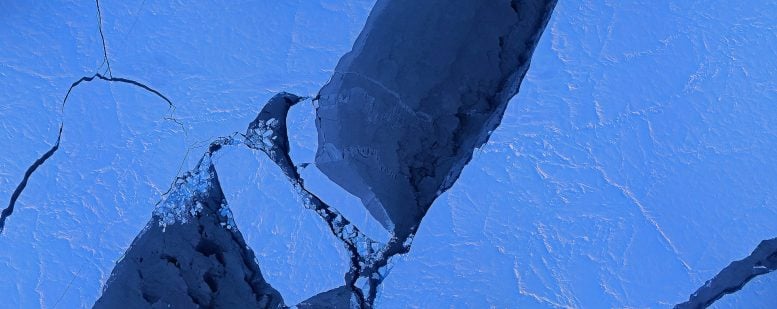
An image mosaic of sea ice in the Canadian Basin, taken by Operation IceBridge’s Digital Mapping System on Mar. 28, 2014. Credit: Digital Mapping System/NASA Ames
A new study by NSIDC and NASA researchers reveals that length of the melt season for Arctic sea ice is growing by several days each decade.
The length of the melt season for Arctic sea ice is growing by several days each decade, and an earlier start to the melt season is allowing the Arctic Ocean to absorb enough additional solar radiation in some places to melt as much as four feet of the Arctic ice cap’s thickness, according to a new study by National Snow and Ice Data Center (NSIDC) and NASA researchers.
“The Arctic is warming and this is causing the melt season to last longer,” said Julienne Stroeve, a senior scientist at NSIDC, Boulder and lead author of the new study, which has been published in Geophysical Research Letters. “The lengthening of the melt season is allowing for more of the sun’s energy to get stored in the ocean and increase ice melt during the summer, overall weakening the sea ice cover.”
A short video summarizes new findings about Arctic sea ice and warming oceans.
Arctic sea ice has been in sharp decline during the last four decades. The sea ice cover is shrinking and thinning, making scientists think an ice-free Arctic Ocean during the summer might be reached this century. The seven lowest September sea ice extents in the satellite record have all occurred in the past seven years.
To study the evolution of sea ice melt onset and freeze-up dates from 1979 to the present day, Stroeve’s team used passive microwave data from NASA’s Nimbus-7 Scanning Multichannel Microwave Radiometer, and the Special Sensor Microwave/Imager and the Special Sensor Microwave Imager and Sounder carried onboard Defense Meteorological Satellite Program spacecraft. When ice and snow begin to melt, the presence of water causes spikes in the microwave radiation that the snow grains emit, which these sensors can detect.
Results show that although the melt season is lengthening at both ends, with an earlier melt onset in the spring and a later freeze-up in the fall, the predominant phenomenon extending the melting is the later start of the freeze season. Some areas, such as the Beaufort and Chukchi Seas, are freezing up between six and 11 days later per decade. Although melt onset variations are smaller, the timing of the beginning of the melt season has a larger impact on the amount of solar radiation absorbed by the ocean, because its timing coincides with when the sun is higher and brighter in the Arctic sky.
Despite large regional variations in the beginning and end of the melt season, the Arctic melt season has lengthened on average by five days per decade from 1979 to 2013.
Reference: “Changes in Arctic melt season and implications for sea ice loss” by J. C. Stroeve, T. Markus, L. Boisvert, J. Miller and A. Barrett, 4 February 2014, Geophysical Research Letters.
DOI: 10.1002/2013GL058951








Be the first to comment on "Arctic Melt Season Is Lengthening by Several Days Each Decade"